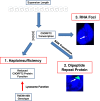The widening spectrum of C9ORF72-related disease; genotype/phenotype correlations and potential modifiers of clinical phenotype
- PMID: 24493408
- PMCID: PMC3925297
- DOI: 10.1007/s00401-014-1251-9
The widening spectrum of C9ORF72-related disease; genotype/phenotype correlations and potential modifiers of clinical phenotype
Abstract
The GGGGCC (G4C2) repeat expansion in C9ORF72 is the most common cause of familial amyotrophic lateral sclerosis (ALS), frontotemporal lobar dementia (FTLD) and ALS-FTLD, as well as contributing to sporadic forms of these diseases. Screening of large cohorts of ALS and FTLD cohorts has identified that C9ORF72-ALS is represented throughout the clinical spectrum of ALS phenotypes, though in comparison with other genetic subtypes, C9ORF72 carriers have a higher incidence of bulbar onset disease. In contrast, C9ORF72-FTLD is predominantly associated with behavioural variant FTD, which often presents with psychosis, most commonly in the form of hallucinations and delusions. However, C9ORF72 expansions are not restricted to these clinical phenotypes. There is a higher than expected incidence of parkinsonism in ALS patients with C9ORF72 expansions, and the G4C2 repeat has also been reported in other motor phenotypes, such as primary lateral sclerosis, progressive muscular atrophy, corticobasal syndrome and Huntington-like disorders. In addition, the expansion has been identified in non-motor phenotypes including Alzheimer's disease and Lewy body dementia. It is not currently understood what is the basis of the clinical variation seen with the G4C2 repeat expansion. One potential explanation is repeat length. Sizing of the expansion by Southern blotting has established that there is somatic heterogeneity, with different expansion lengths in different tissues, even within the brain. To date, no correlation with expansion size and clinical phenotype has been established in ALS, whilst in FTLD only repeat size in the cerebellum was found to correlate with disease duration. Somatic heterogeneity suggests there is a degree of instability within the repeat and evidence of anticipation has been reported with reducing age of onset in subsequent generations. This variability/instability in expansion length, along with its interactions with environmental and genetic modifiers, such as TMEM106B, may be the basis of the differing clinical phenotypes arising from the mutation.
Figures


Similar articles
-
The C9ORF72 expansion mutation: gene structure, phenotypic and diagnostic issues.Acta Neuropathol. 2014 Mar;127(3):319-32. doi: 10.1007/s00401-014-1253-7. Epub 2014 Feb 11. Acta Neuropathol. 2014. PMID: 24515836 Review.
-
A C9orf72 promoter repeat expansion in a Flanders-Belgian cohort with disorders of the frontotemporal lobar degeneration-amyotrophic lateral sclerosis spectrum: a gene identification study.Lancet Neurol. 2012 Jan;11(1):54-65. doi: 10.1016/S1474-4422(11)70261-7. Epub 2011 Dec 7. Lancet Neurol. 2012. PMID: 22154785
-
Cerebellar c9RAN proteins associate with clinical and neuropathological characteristics of C9ORF72 repeat expansion carriers.Acta Neuropathol. 2015 Oct;130(4):559-73. doi: 10.1007/s00401-015-1474-4. Epub 2015 Sep 8. Acta Neuropathol. 2015. PMID: 26350237 Free PMC article.
-
Pattern of ubiquilin pathology in ALS and FTLD indicates presence of C9ORF72 hexanucleotide expansion.Acta Neuropathol. 2012 Jun;123(6):825-39. doi: 10.1007/s00401-012-0970-z. Epub 2012 Mar 18. Acta Neuropathol. 2012. PMID: 22426854 Free PMC article.
-
Current insights into the C9orf72 repeat expansion diseases of the FTLD/ALS spectrum.Trends Neurosci. 2013 Aug;36(8):450-9. doi: 10.1016/j.tins.2013.04.010. Epub 2013 Jun 7. Trends Neurosci. 2013. PMID: 23746459 Review.
Cited by
-
Mitochondrial dynamism and the pathogenesis of Amyotrophic Lateral Sclerosis.Front Cell Neurosci. 2015 Feb 10;9:31. doi: 10.3389/fncel.2015.00031. eCollection 2015. Front Cell Neurosci. 2015. PMID: 25713513 Free PMC article. Review.
-
Rac1 at the crossroad of actin dynamics and neuroinflammation in Amyotrophic Lateral Sclerosis.Front Cell Neurosci. 2014 Sep 8;8:279. doi: 10.3389/fncel.2014.00279. eCollection 2014. Front Cell Neurosci. 2014. PMID: 25249940 Free PMC article. Review.
-
The phenotypic variability of amyotrophic lateral sclerosis.Nat Rev Neurol. 2014 Nov;10(11):661-70. doi: 10.1038/nrneurol.2014.184. Epub 2014 Oct 14. Nat Rev Neurol. 2014. PMID: 25311585 Review.
-
BV-2 Microglial Cells Overexpressing C9orf72 Hexanucleotide Repeat Expansion Produce DPR Proteins and Show Normal Functionality but No RNA Foci.Front Neurol. 2020 Oct 6;11:550140. doi: 10.3389/fneur.2020.550140. eCollection 2020. Front Neurol. 2020. PMID: 33123074 Free PMC article.
-
Co-incidental C9orf72 expansion mutation-related frontotemporal lobar degeneration pathology and sporadic Creutzfeldt-Jakob disease.Eur J Neurol. 2021 Mar;28(3):1009-1015. doi: 10.1111/ene.14621. Epub 2020 Dec 1. Eur J Neurol. 2021. PMID: 33131137 Free PMC article.
References
-
- Beck J, Poulter M, Hensman D, Rohrer JD, Mahoney CJ, Adamson G, Campbell T, Uphill J, Borg A, Fratta P, Orrell RW, Malaspina A, Rowe J, Brown J, Hodges J, et al. Large C9orf72 hexanucleotide repeat expansions are seen in multiple neurodegenerative syndromes and are more frequent than expected in the UK population. Am J Hum Genet. 2013;92(3):345–353. doi: 10.1016/j.ajhg.2013.01.011. - DOI - PMC - PubMed
-
- DeJesus-Hernandez M, Mackenzie IR, Boeve BF, Boxer AL, Baker M, Rutherford NJ, Nicholson AM, Finch NA, Flynn H, Adamson J, Kouri N, Wojtas A, Sengdy P, Hsiung GY, Karydas A, et al. Expanded GGGGCC hexanucleotide repeat in noncoding region of C9ORF72 causes chromosome 9p-linked FTD and ALS. Neuron. 2011;72(2):245–256. doi: 10.1016/j.neuron.2011.09.011. - DOI - PMC - PubMed
-
- Renton AE, Majounie E, Waite A, Simon-Sanchez J, Rollinson S, Gibbs JR, Schymick JC, Laaksovirta H, van Swieten JC, Myllykangas L, Kalimo H, Paetau A, Abramzon Y, Remes AM, Kaganovich A, et al. A hexanucleotide repeat expansion in C9ORF72 is the cause of chromosome 9p21-linked ALS-FTD. Neuron. 2011;72(2):257–268. doi: 10.1016/j.neuron.2011.09.010. - DOI - PMC - PubMed
-
- Cooper-Knock J, Hewitt C, Highley JR, Brockington A, Milano A, Man S, Martindale J, Hartley J, Walsh T, Gelsthorpe C, Baxter L, Forster G, Fox M, Bury J, Mok K, et al. Clinico-pathological features in amyotrophic lateral sclerosis with expansions in C9ORF72. Brain. 2012;135(Pt 3):751–764. doi: 10.1093/brain/awr365. - DOI - PMC - PubMed
-
- Majounie E, Renton AE, Mok K, Dopper EG, Waite A, Rollinson S, Chio A, Restagno G, Nicolaou N, Simon-Sanchez J, van Swieten JC, Abramzon Y, Johnson JO, Sendtner M, Pamphlett R, et al. Frequency of the C9orf72 hexanucleotide repeat expansion in patients with amyotrophic lateral sclerosis and frontotemporal dementia: a cross-sectional study. Lancet Neurol. 2012;11(4):323–330. doi: 10.1016/S1474-4422(12)70043-1. - DOI - PMC - PubMed
Publication types
MeSH terms
Substances
Grants and funding
LinkOut - more resources
Full Text Sources
Other Literature Sources
Medical
Molecular Biology Databases
Miscellaneous

